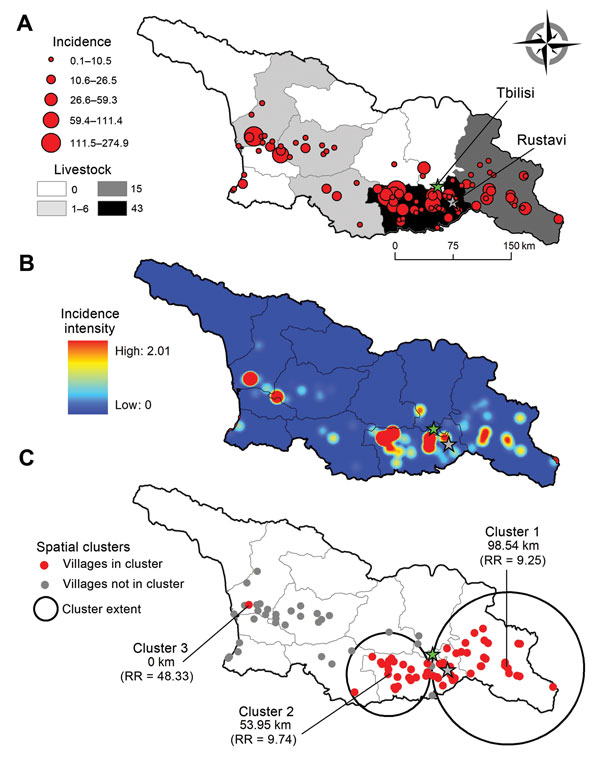Volume 20, Number 2—February 2014
Dispatch
Human Cutaneous Anthrax, Georgia 2010–2012
Figure 2

Figure 2. A) Empirical Bayes Smoothing cumulative incidence (per 10,000 population) of human cutaneous anthrax at the community level, Georgia, 2010–2012. Green star indicates the location of the capital, Tbilisi; gray star indicates the fourth most populous city, Rustavi. The total number of livestock cases during the study period is shown by region. B) Risk surface representing the estimated smoothed cumulative incidence per square kilometer. C) Spatial clustering of human cutaneous anthrax cases as determined by using SaTScan (7). RR, risk ratio.
References
- Hugh‐Jones M. 1996–97 Global anthrax report. J Appl Microbiol. 1999;87:189–91 . DOIPubMedGoogle Scholar
- World Health Organization. Anthrax in humans and animals: 4th ed. [cited 2013 Feb 10]. http://www.who.int/csr/resources/publications/anthrax_web.pdf
- Woods CW, Ospanov K, Myrzabekov A, Favorov M, Plikaytis B, Ashford DA. Risk factors for human anthrax among contacts of anthrax-infected livestock in Kazakhstan. Am J Trop Med Hyg. 2004;71:48–52 .PubMedGoogle Scholar
- Global Infectious Disease and Epidemiology Network. Anthrax in Georgia [cited 2013 Mar 20]. web.gideon.com/web/epidemiology/#
- Kracalik IT, Malania L, Tsertsvadze N, Manvelyan J, Bakanidze L, Imnadze P, Evidence of local persistence of human anthrax in the country of Georgia associated with environmental and anthropogenic factors. PLoS Negl Trop Dis. 2013;7:e2388. DOIPubMedGoogle Scholar
- Malaniia LO, Imnadze PG, Katsitadze GK, Tsanava SA, Bakanidze LG. Anthrax in Georgia: epidemiological situation and prognosis [in Russian]. Georgian Med News. 2006; (
130 ):67–71 .PubMedGoogle Scholar - Doganay M, Metan G. Human anthrax in Turkey from 1990 to 2007. Vector Borne Zoonotic Dis. 2009;9:131–40. DOIPubMedGoogle Scholar
- Özkurt Z, Parlak M, Tastan R, Dinler U, Saglam YS, Ozyurek SF. Anthrax in eastern Turkey, 1992–2004. Emerg Infect Dis. 2005;11:1939–41 .PubMedGoogle Scholar
- Chakraborty A, Khan SU, Hasnat MA, Parveen S, Islam MS, Mikolon A, Anthrax outbreaks in Bangladesh, 2009–2010. Am J Trop Med Hyg. 2012;86:703–10. DOIPubMedGoogle Scholar
- Maudlin I, Eisler MC, Welburn SC. Neglected and endemic zoonoses. Philos Trans R Soc Lond B Biol Sci. 2009;364:2777–87 and. DOIPubMedGoogle Scholar
- Kartvelishvili T. Cattle sector and dairy chain developments in Georgia, Azerbaijan and Armenia. In: Peters KJ, Kuipers A, Keane MG, Dimitriadou A, editors. The cattle sector in central and eastern Europe: developments and opportunities in a time of transition. Wageningen (the Netherlands): Wageningen Academic Publishers; 2009. p. 133–52.
- Gurbanov S, Akhmedova S. Especially dangerous infections in Azerbaijan. In: O'Connell KP, Skowronski EW, Sulakvelidze A, Bakanidze L, editors. Emerging and endemic pathogens: advances in surveillance, detection and identification. Dordrecht (the Netherlands): Springer; 2010. p. 39–43.
- Kracalik IT, Blackburn JK, Lukhnova L, Pazilov Y, Hugh-Jones ME, Aikimbayev A. Analyzing the spatial patterns of livestock anthrax in Kazakhstan in relation to environmental factors: a comparison of local (Gi*) and morphology cluster statistics. Geospat Health. 2012;7:111–26 .PubMedGoogle Scholar
1These authors contributed equally to this article.
Page created: January 17, 2014
Page updated: January 17, 2014
Page reviewed: January 17, 2014
The conclusions, findings, and opinions expressed by authors contributing to this journal do not necessarily reflect the official position of the U.S. Department of Health and Human Services, the Public Health Service, the Centers for Disease Control and Prevention, or the authors' affiliated institutions. Use of trade names is for identification only and does not imply endorsement by any of the groups named above.